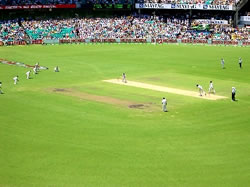No, really, is this the most competitive era in cricket history?
Dave Wilson |
In September, CW’s Will Quinn penned an interesting analysis entitled “The Most Competitive Era in Cricket History”, and outlined each of the current heavyweights who are jockeying for the title of undisputed number one. Of course, it’s difficult for us to assess how competitive other eras were, partly because we tend to romanticise the past and partly because we weren’t around to witness it (well, most of us anyway).
It occurred to me that I had a way to investigate this objectively, using the historical Test rankings which I researched for this article. Since Test cricket began, I’ve generated the equivalent ICC rankings for each nation – these tables can be used to assess the competitive balance of different eras. I’ve modified the original tables a little since the first article was drafted, to compensate for the effect of deliberately under-strength teams, such as the England teams which faced South Africa before WW1 and inexperienced sides selected to face countries who have recently been given Test status.
There are several ways to measure competitiveness; first, taking the average of all Test nations rating; second, measuring the spread of the team ratings; third, measuring the average of the strongest teams. The first measure, total average, tells us how strong all of the Test-playing nations taken together are in a given time period. The second measure, the relative spread, tells us how dominant the top team(s) are. The third measure, the average of the top few teams, tells us how many strong teams there were.
I decided to go back no further than 1930, by which time there were five Test-playing nations, with West Indies and New Zealand joining England, Australia and South Africa. Also, I’ve excluded Zimbabwe and Bangladesh – Bangladesh for obvious reasons, and Zimbabwe as they only really approached the strength of the other nations for a relatively short period.
So looking at the first measure, we are certainly enjoying a period of Test cricket with one of the highest ever overall average ratings. The period with the highest average rating was between 2007 and 2008, when the average of all teams was 105. Although this was certainly a time of several strong teams, the average is skewed so high partly due to Australia’s extremely high rating (143 at its height). Our current era scores next best, where we do indeed have four very strong teams (five including England, although they are a little further back). 2003 averages very well, with Austrlia (129) and South Africa (119) leading the pack ahead of a resurgent New Zealand (106). No other time period in history has seen a total average over 100 – the next best was in 1969, which occurred just before South Africa, the leading nation at that time on 125, were excluded from cricket and the rankings, significantly dropping the overall strength. Other periods have not been nearly so strong in terms of overall average rating.
Looking at the second measure, the spread, this tells us how closely matched the teams were. The smallest spread, and by a significant margin (only 18 points covered all of the ranked teams), came during the beginning of the 1980s, just before Sri Lanka first played Test cricket – this was almost certainly due mainly to the exodus of the best players to World Series Cricket, weakening the better teams and thereby making the weaker teams more competitive. The next smallest spread was in 1999, when South Africa led the pack with the relatively low rating of 113, and only eight ratings points separated third placed Sri Lanka from New Zealand in eighth. The next most competitive era in terms of spread was in 1974, when India were ranked first with an even lower total of 105, just one point ahead of Australia.
The third measure of competitiveness, and the one most closely related to Will’s original analysis, is the average of the top teams. I’ve chosen to average the top four teams, to attempt to strike a balance between the earlier eras where there were fewer teams in total, and the present era, when we have so many strong teams. The first such peak was 1954, when Australia (115), England (112) and West Indies (108) were all closely ranked. This peak was overtaken in 1962 with the same teams ranked in the top three, but with significantly higher ratings points (129, 114 and 115 respectively). The top four teams in 1969 averaged a new high, with the South Africans (125) outpacing England (118) and Australia (112). There was a lull after this point until 2002, when the average of the top teams continued to rise gradually and continually – however this wasn’t always a measure of competitiveness insofar as it was a measure of Australia’s dominance, at least until now, where we are seeing the highest average ever for the top four teams – South Africa (122), Sri Lanka (120), India (119) and Australia (116) average 119.3.
To give an idea of the level of competitiveness we’re enjoying in Test cricket at this time, the average score of the current top four teams would represent the top ranking in 45 of the years covered by my historical rankings. I think it’s fair to say that Test cricket is considered most competitive when it has more strong teams vying for the top spot, rather than a lot of closely-matched but relatively mediocre teams, so in conclusion, we can confidently state that the title of Will’s original article is not a misnomer – this is indeed the most competitive era in cricket history.





Good stuff mate!
Comment by Uppercut | 12:00am GMT 18 November 2009